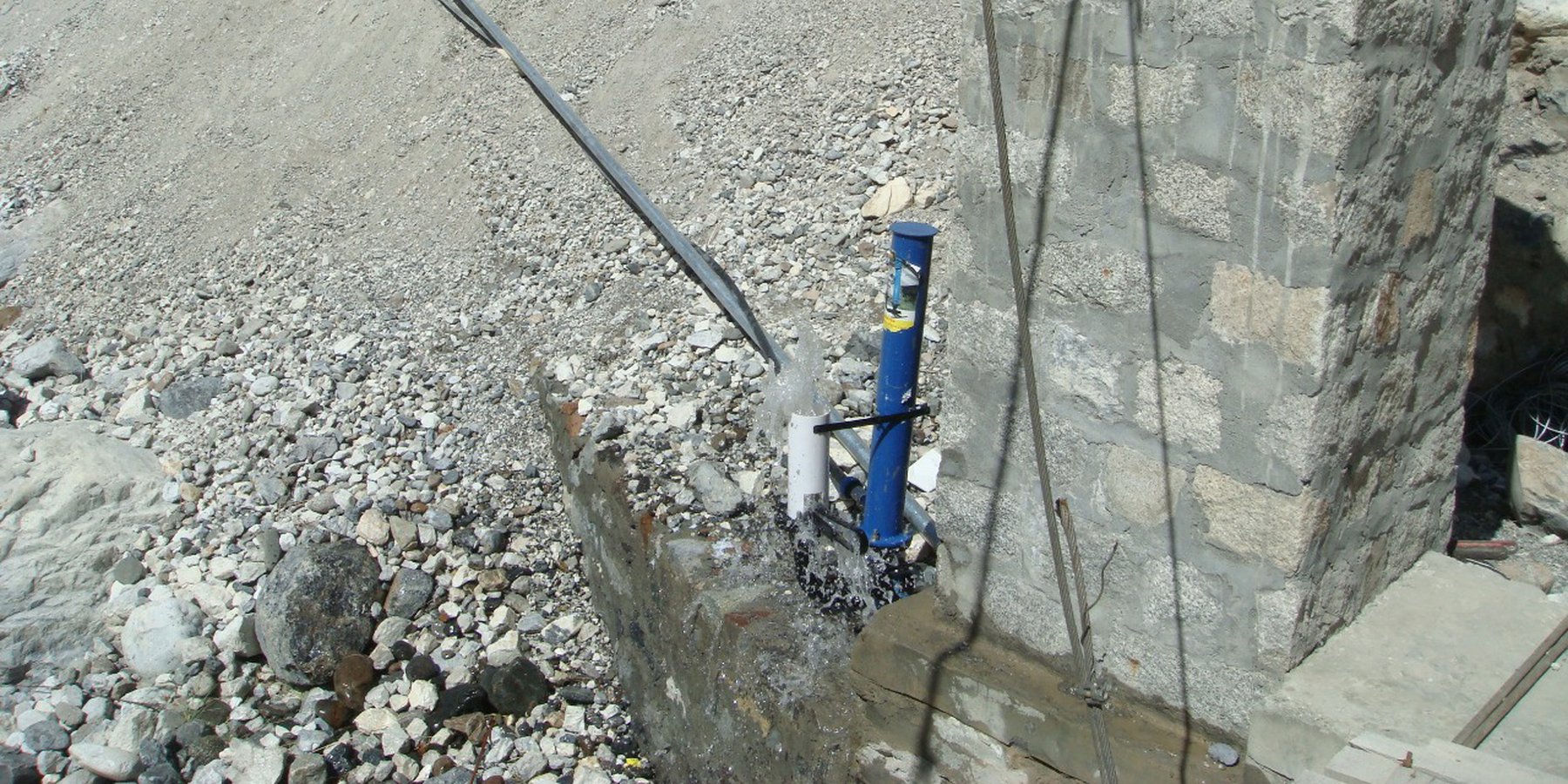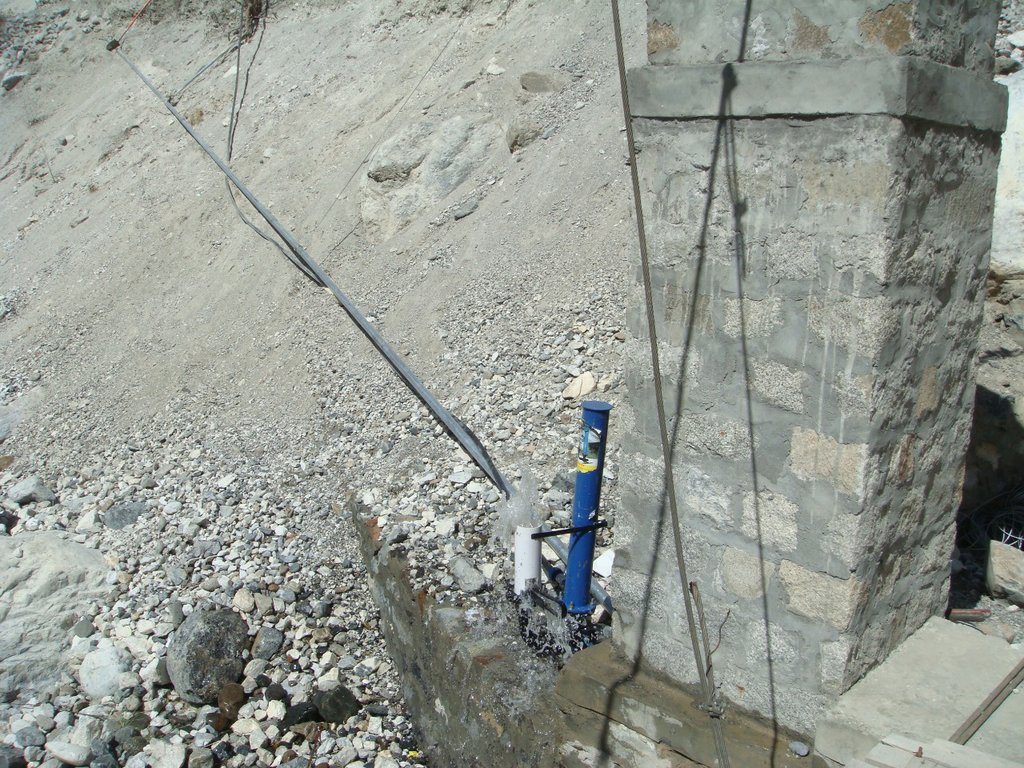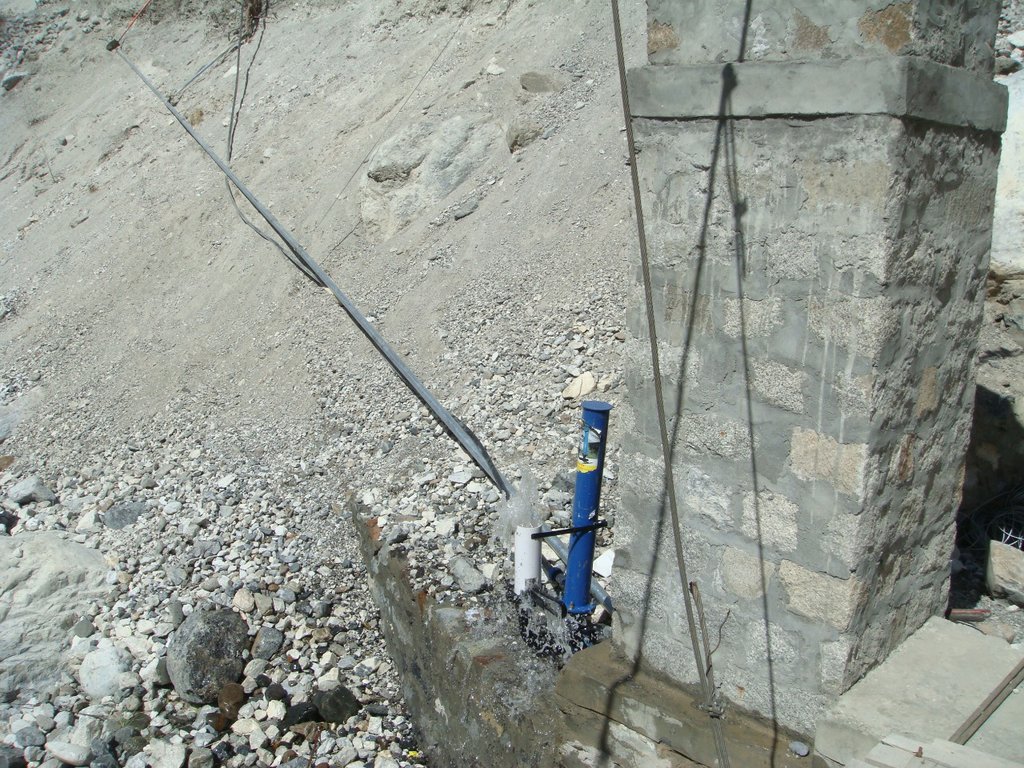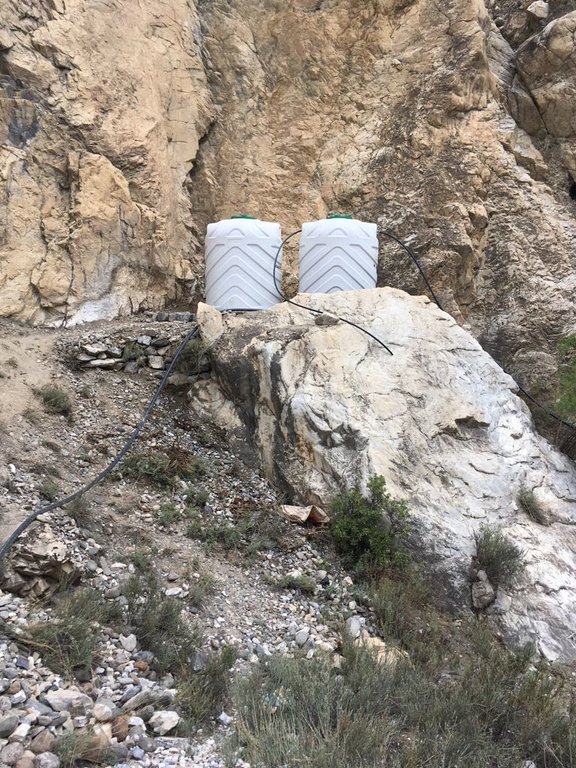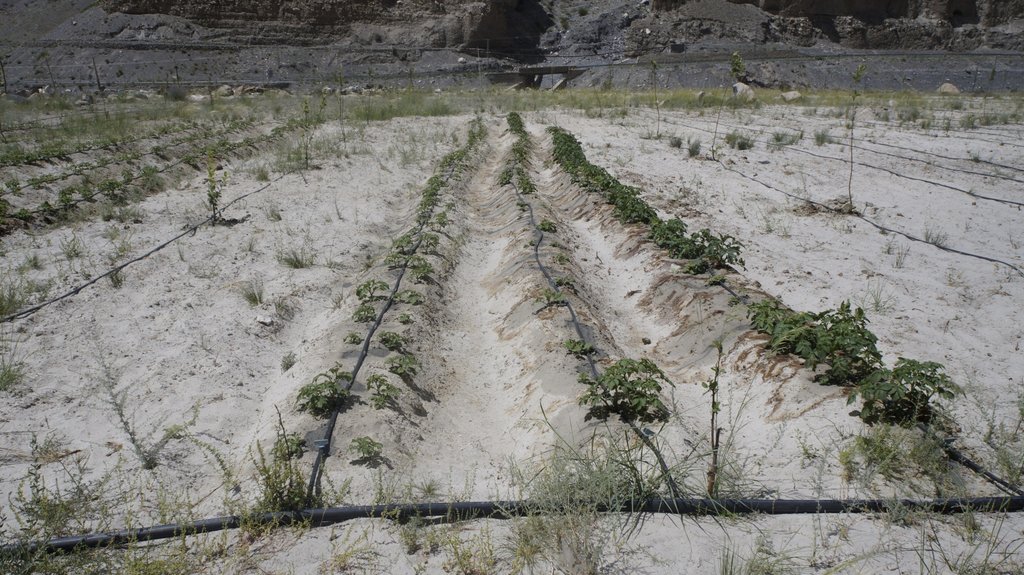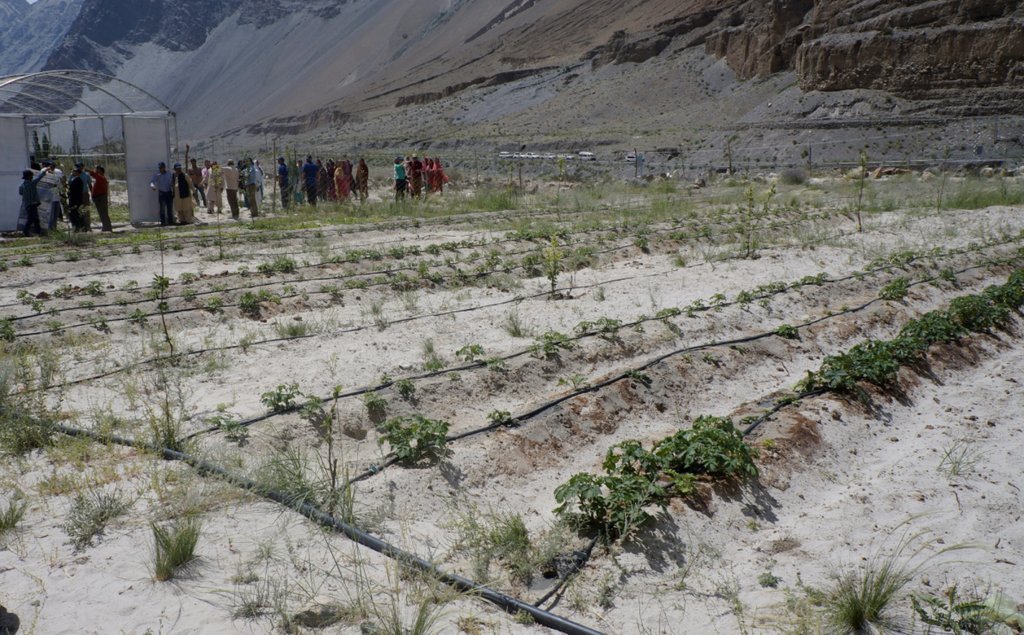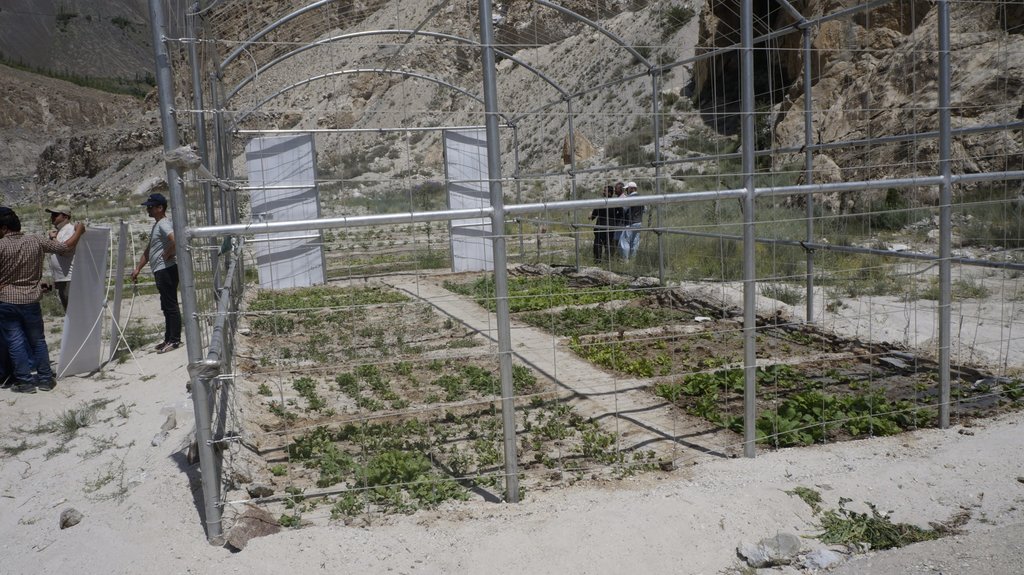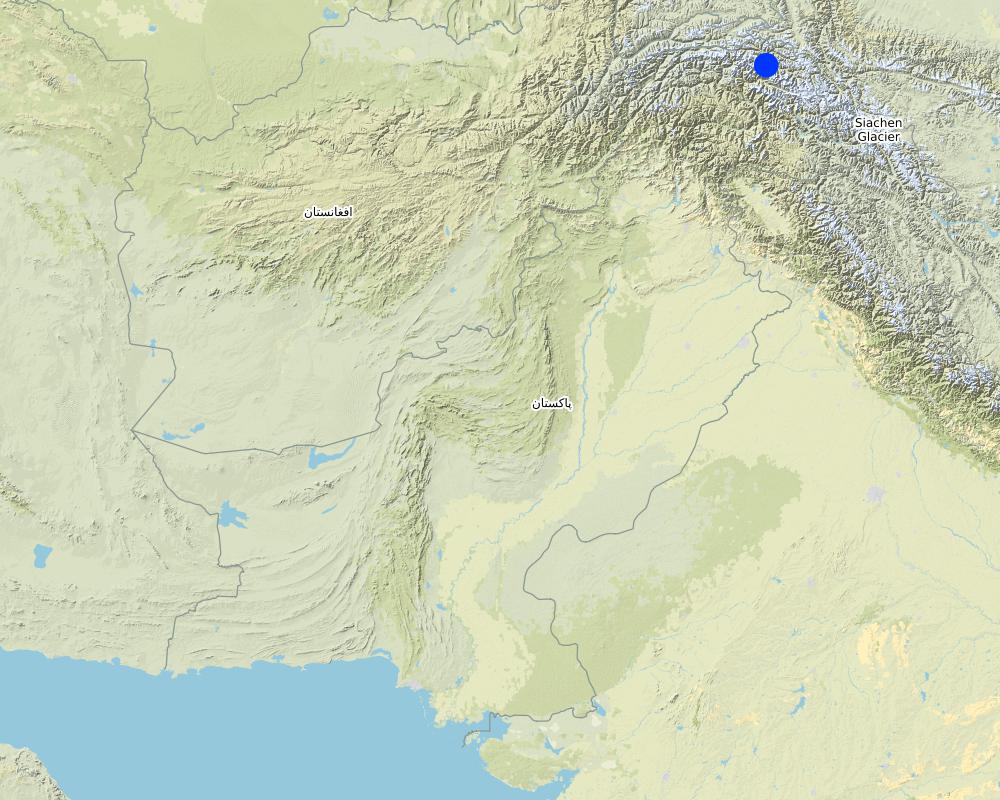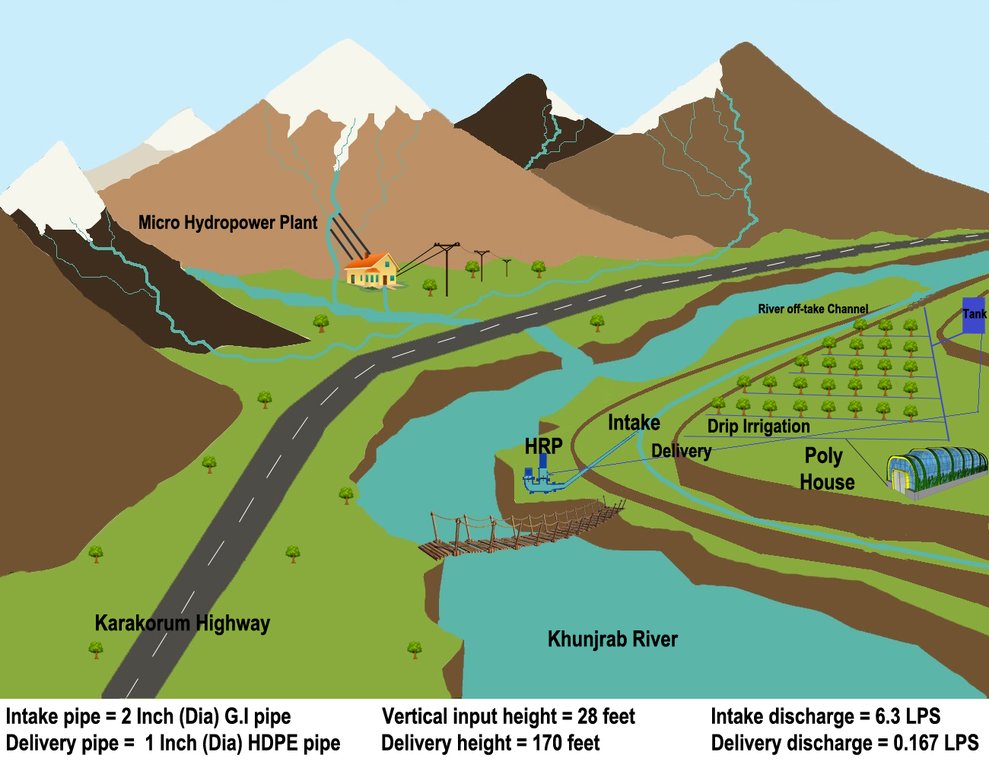Hydraulic Ram Pump assisted river water lifting and application of stored water through drip irrigation for alley cropping [ប្រទេសបាគីស្ថាន]
- ការបង្កើត៖
- បច្ចុប្បន្នភាព
- អ្នកចងក្រង៖ Muhammad Mudassar Maqsood
- អ្នកកែសម្រួល៖ –
- អ្នកត្រួតពិនិត្យច្រើនទៀត៖ Rima Mekdaschi Studer, Ursula Gaemperli
Hydram Pump
technologies_5740 - ប្រទេសបាគីស្ថាន
ពិនិត្យមើលគ្រប់ផ្នែក
ពង្រីកមើលទាំងអស់ បង្រួមទាំងអស់1. ព័ត៌មានទូទៅ
1.2 ព័ត៌មានលម្អិតពីបុគ្គលសំខាន់ៗ និងស្ថាប័នដែលចូលរួមក្នុងការវាយតម្លៃ និងចងក្រងឯកសារនៃបច្ចេកទេស
បុគ្គលសំខាន់ម្នាក់ (ច្រើននាក់)
អ្នកជំនាញឯកទេស SLM:
Maqsood Muhammad Mudassar
International Centre for Integrated Mountain Development (ICIMOD)
ប្រទេសបាគីស្ថាន
អ្នកជំនាញឯកទេស SLM:
Shrestha Arun Bhakta
International Centre for Integrated Mountain Development (ICIMOD)
ប្រទេសនេប៉ាល់
អ្នកជំនាញឯកទេស SLM:
Raza Haider
WWF-Pakistan
ប្រទេសបាគីស្ថាន
អ្នកជំនាញឯកទេស SLM:
Dhakal Madhav
International Centre for Integrated Mountain Development (ICIMOD)
ប្រទេសនេប៉ាល់
អ្នកជំនាញឯកទេស SLM:
Ali Ajaz
International Centre for Integrated Mountain Development (ICIMOD)
ប្រទេសបាគីស្ថាន
អ្នកជំនាញឯកទេស SLM:
Hassan Faizan-ul-
Pakistan Council of Research in Water Resources
ប្រទេសបាគីស្ថាន
អ្នកជំនាញឯកទេស SLM:
Karim Fazal
WWF-Pakistan
ប្រទេសបាគីស្ថាន
Consultant:
Azeem-ullah
Azeemullah & Company Chartered Accountants
ប្រទេសបាគីស្ថាន
អ្នកជំនាញឯកទេស SLM:
Kundi Rehmat-ullah
GetGreen Tech
ប្រទេសបាគីស្ថាន
អ្នកជំនាញឯកទេស SLM:
Shah Ghulam Muhammad
International Centre for Integrated Mountain Development (ICIMOD)
ប្រទេសបាគីស្ថាន
ឈ្មោះគម្រោងដែលបានចងក្រងឯកសារ/ វាយតម្លៃលើបច្ចេកទេស (បើទាក់ទង)
Agricultural Water, Energy, and Hazard Management for Improved Livelihood in the Upper Indus Basin, Pakistan (UIB, Pakistan)ឈ្មោះអង្គភាពមួយ (ច្រើន) ដែលបានចងក្រងឯកសារ/ វាយតម្លៃបច្ចេកទេស (បើទាក់ទង)
ICIMOD International Centre for Integrated Mountain Development (ICIMOD) - ប្រទេសនេប៉ាល់1.3 លក្ខខណ្ឌទាក់ទងទៅនឹងការប្រើប្រាស់ទិន្នន័យដែលបានចងក្រងតាមរយៈ វ៉ូខេត
អ្នកចងក្រង និង(បុគ្គលសំខាន់ៗ)យល់ព្រមទទួលយកនូវលក្ខខណ្ឌនានាទាក់ទងទៅនឹងការប្រើប្រាស់ទិន្នន័យដែលបានចងក្រងតាមរយៈវ៉ូខេត:
បាទ/ចា៎
1.4 សេចក្តីប្រកាសស្តីពីចីរភាពនៃការពណ៌នាពីបច្ចេកទេស
តើបច្ចេកទេសដែលបានពណ៌នានេះមានបញ្ហាដែលផ្តោតលើការធ្លាក់ចុះគុណភាពដី, បើដូច្នេះវាមិនអាចត្រូវបានប្រកាសថាជាបច្ចេកទេសនៃការគ្រប់គ្រងប្រកបដោយចីរភាពទេ?
ទេ
2. ការពណ៌នាពីបច្ចេកទេស SLM
2.1 ការពណ៌នាដោយសង្ខេបពីបច្ចេកទេស
និយមន័យបច្ចេកទេស:
The water from a contour canal (off-taking from Khunjrab River) was lifted through hydro ram pump to uphill plastic storage and distributed to alley cropping (newly established orchard and vegetable rows) through drip irrigation.
2.2 ការពណ៌នាលម្អិតពីបច្ចេកទេស
ការពណ៌នា:
Agriculture, livestock herding and tourism are the major contributors to Gilgit Baltistan economy. The arable land in this region is limited (only 2%) and more than half of which is still barren due to unavailability of irrigation water supplies. The reported dependency of irrigated areas on glacier fed irrigation is more than 90 percent, which now have been fluctuating due to changing climate. This region has been experiencing drastic changes in climate which resulting into lowering of glacier and water related disasters leading towards discontinuity of irrigation water supplies. The electrical power energy options are limited as well as unreliable and in situ replacements are very expensive.
The technological package was applied in arid climate at an elevation ranging from 2340m to 4877 m above sea level. Khyber is located at 36.56o N latitude and 74.79o E longitude. The area receives 150-200 mm annual rain-fall. The population of Khyber village is 1200 residing in 150 houses. Almost 46 percent of population is salaried, 20 percent own business and roughly 19 percent engaged with farming to earn bread and butter for families. The average landholding per household is 3.8 acres out of which 1.25 acre is cultivable waste due to insufficient water supplies and local labor.
To address the above issues, the Indus Basin Initiative (IBI) of International Centre for Integrated Mountain Development (ICIMOD) through its a consortium of local partners including Pakistan Council of Research in Water Resources (PCRWR), Mountain Agriculture Research Centre (MARC) and WWF-Pakistan has been demonstrating the alternative agricultural water management package of practices in lifting water for irrigation using Hydro ram pump. This study also presents the findings based on the experiment/demonstration and testing conducted in the pilot. The pilot site is located in Khyber village of Hunza, Gilgit Baltistan.
The pumping unit comprises a hydro ram pump (which is a zero carbon emission technology and needs no electricty to run, and it is locally customized having 1 inch/25mm out-take pipe) to lift water from a contour channel originating from the Khunjrab River and to carry the water to storage tanks (4000 liters) made up of plastic that has been placed upslope at 175 feet (53,3 m) vertical height from the river. The water from the storage tanks was supplied to alley cropping (apple sapling rows and vegetables rows) through pressure compensating drip irrigation system. The pumping capacity of the pump is 10.2 liters/minute, which is irrigating around 350 apple plants and vegetable rows at 2.5 acre (1ha). The storage tank was kept 45 feet (13,5 m) vertical height from the orchard field. Plan to plant distance and row to row distance of apple was maintained at 15 feet (4,6 m) and 20 (6 m) feet respectively. Drip irrigation system was established for each apple plant, as well as vegetables rows. Pits were constructed for planting apples and later they served also as water harvesting pits /check basins. Gilgit Baltistan chapter of WWF-Pakistan mobilized the local community, while PCRWR and MARC provided technical support to the Khyber Community in establishment of this pilot site. The community youth provided voluntary support during the land preparation, plantation and installation of hydro ram pump as well as drip irrigation system and the uphill storage tanks.
The cost of a complete package including hydro ram pump with accessories, storage tanks, intake and distribution systems, drip irrigation, apple plants and operational expenses for the site was US$ 25, 865 for 2.5 acre (1ha) of land. Women Organization of Khyber village takes care of the maintenance of technological package (fortnightly desilting of drip irrigation and storage tanks and annual repair of hydraulic ram pump). The fruit production has not yet started as it is a newly established farming site. However, seasonal vegetable farming has just started. The produce is small as soil fertility is still building up. Currently, the grown vegetables are being sold or used in the village at household level. However, with higher yield in future, the total income from the farm produce (currenty vegetables only) would be divided equally among the participating 150 households of Khyber Village. A comprehensive cost benefit analysis study has been conducted. It has been envisioned that apple orchard would mature in 4 to 5 years in cold climate of Gojal. By the 6th year, the farm would produce enough to the reach break-event point. The vegetable production has started now and the envisioned annual income is 15,000 PKR (almost 111 USD, if 1 USD=135 PKR).
The community welcomed the new technology and is now planning to outscale it in other areas to bring more land under cultivation. The women organization in the pilot site are positive about the less labourous agricultural activities and foresee to extend the alley cropping under drip irrigation to the rest of 7.5 acres, too. This technology is being dessiminated to different stakeholders including practitioners, policy and decision makers, academia, researchers and local farming communities. For this purpose, exposure field visits and farmers' field days have been arranged by the implementation partners.
2.3 រូបភាពនៃបច្ចេកទេស
2.5 ប្រទេស/តំបន់/ទីតាំងកន្លែង ដែលបច្ចេកទេសត្រូវបានអនុវត្ត និងបានគ្រប់ដណ្តប់ដោយការវាយតម្លៃនេះ
ប្រទេស:
ប្រទេសបាគីស្ថាន
តំបន់/រដ្ឋ/ខេត្ត:
Gilgit Baltistan
បញ្ជាក់បន្ថែមពីលក្ខណៈនៃទីតាំង:
Khyber Village, Hunza District
បញ្ជាក់ពីការសាយភាយនៃបច្ចេកទេស:
- អនុវត្តនៅកន្លែងជាក់លាក់មួយ/ ប្រមូលផ្តុំនៅតំបន់តូចៗ
តើបច្ចេកទេស (មួយ ឬច្រើន) ទាំងនោះស្ថិតនៅក្នុងតំបន់ការពារជាអចិន្ត្រៃយ៍ណាមួយដែរឬទេ?
បាទ/ចា៎
បើបាទ/ច៎ា សូមបញ្ជាក់:
The community has protected the site with barbed wire with wooden posts.
Map
×2.6 កាលបរិច្ឆេទនៃការអនុវត្ត
បង្ហាញឆ្នាំនៃការចុះអនុវត្ត:
2018
ប្រសិនបើមិនច្បាស់ឆ្នាំ សូមបញ្ជាក់កាលបរិច្ឆេទដែលប្រហាក់ប្រហែល:
- តិចជាង 10ឆ្នាំមុន (ថ្មី)
2.7 ការណែនាំពីបច្ចេកទេស
សូមបញ្ជាក់តើបច្ចេកទេសត្រូវបានណែនាំឱ្យអនុវត្តដោយរបៀបណា:
- តាមរយៈគម្រោង / អន្តរាគមន៍ពីខាងក្រៅ
មតិយោបល់ (ប្រភេទនៃគម្រោង ។ល។):
The Indus Basin Initiative of ICIMOD, with support of Government of Australia under Sustainable Development Investment Portfolio (SDIP), has been developing capacity (resilience to climate change) of vulnerable communities of Gilgit Baltistan through pioneer introduction of contextually new innovative technologies.
3. ចំណាត់ថ្នាក់នៃបច្ចេកទេស SLM
3.1 គោលបំណងចម្បង (១ ឬច្រើន) នៃបច្ចេកទេសនេះ
- ធ្វើឱ្យប្រសើរឡើងនូវផលិតកម្ម
- កាត់បន្ថយ, បង្ការ, ស្តារឡើងវិញនូវការធ្លាក់ចុះគុណភាពដី
- បន្ស៊ាំទៅនឹងការប្រែប្រួលអាកាសធាតុ/គ្រោះមហន្តរាយ និងផលប៉ះពាល់របស់វា
- បង្កើតផលប្រយោជន៍សេដ្ឋកិច្ច
- បង្កើតផលប្រយោជន៍សង្គម
3.2 ប្រភេទដីប្រើប្រាស់មួយប្រភេទ (ច្រើនប្រភេទ) ដែលបានអនុវត្តបច្ចេកទេស

ដីដាំដំណាំ
- ដំណាំប្រចាំឆ្នាំ
- ប្រភេទដើមឈើធំៗ និងដើមឈើតូចៗ
ដំណាំប្រចាំឆ្នាំ - បញ្ជាក់ប្រភេទដំណាំ:
- បន្លែ - បន្លែយកស្លឹក (សាលាដ ស្ពៃក្តោប ផ្ទី ផ្សេងៗ)
ប្រភេទដើមឈើធំៗ និងដើមឈើតូចៗ - បញ្ជាក់ប្រភេទ:
- ផ្លែឈើផ្សេងៗ
ចំនួនសារដែលដាំដំណាំក្នុងមួយឆ្នាំ:
- 1
សូមបញ្ជាក់:
Only one crop is grown owing to the climate of this area
តើជាការអនុវត្តន៍ដំណាំចន្លោះ?
បាទ/ចា៎
ប្រសិនបើបាទ/ច៎ា សូមបញ្ជាក់ប្រភេទដំណាំដែលដាំចន្លោះគ្នានោះ:
The seasonal vegetables are grown in between two successive apple orchard rows meaning Alley Cropping.
តើជាការអនុវត្តន៍ដំណាំវិលជុំ?
ទេ
3.3 បន្ទាប់ពីអនុវត្តបច្ចេកទេស តើដីប្រើប្រាស់មានការប្រែប្រួលដែររឺទេ?
បន្ទាប់ពីអនុវត្តបច្ចេកទេស តើដីប្រើប្រាស់មានការប្រែប្រួលដែររឺទេ?
- បាទ/ច៎ា (សូមបំពេញសំណួរខាងក្រោមពីស្ថានភាពដីប្រើប្រាស់មុនពេលអនុវត្តបច្ចេកទេស)
ដីប្រើប្រាស់ចម្រុះនៅលើដីតែមួយ:
ទេ

ដីខ្សោះជីជាតិ
សូមបញ្ជាក់:
Barren land
កំណត់សម្គាល់:
Due to unavailability of glacial-melt water, 50% of arable land in Gilgit Baltistan could never be cultivated. Before the interventions were implemented, this land was left barren.
3.4 ការផ្គត់ផ្គង់ទឹក
ការផ្គត់ផ្គង់ទឹកនៅកន្លែងអនុវត្តបច្ចេកទេស:
- ប្រព័ន្ធស្រោចស្រពទាំងស្រុង
មតិយោបល់:
River water is being lifted throuh hydro ram pump, stored in elevated storage tanks and distributed through drip irrigation
3.5 ក្រុម SLM ដែលបច្ចេកទេសស្ថិតនៅក្នុង
- ការគ្រប់គ្រងប្រព័ន្ធស្រោចស្រព (រួមទាំងការផ្គត់ផ្គង់ទឹក ប្រព័ន្ធបង្ហូរ)
- ការគ្រប់គ្រងទឹកលើដី (ទឹកធ្លាក់ ទន្លេ បឹង សមុទ្រ)
- បច្ចេកទេសប្រើប្រាស់ថាមពលមានប្រសិទ្ធភាព
3.6 វិធានការ SLM ដែលបញ្ចូលនូវបច្ចេកទេស

វិធានការក្សេត្រសាស្ត្រ
- A1: ដំណាំ/គម្របដី

វិធានការរុក្ខជាតិ
- V1: ឈើធំៗ និងដើមឈើតូចៗ

វិធានការគ្រប់គ្រង
- M1: ការផ្លាស់ប្តូរប្រភេទដីប្រើប្រាស់
3.7 កំណត់ប្រភេទនៃការធ្លាក់ចុះគុណភាពដីសំខាន់ៗដែលបច្ចេកទេសនេះបានដោះស្រាយ

ការហូរច្រោះដីដោយសារទឹក
- Wt: ការបាត់ដីស្រទាប់លើដោយការហូរច្រោះ

ការបាត់ដីដោយសារខ្យល់
- Et: ការបាត់បង់ដីស្រទាប់លើ

ការបាត់បង់ទឹក
- Ha: ការថយចុះសំណើមដី
មតិយោបល់:
Damage and dysfunction of irrigation canal, due to water related disasters.
3.8 ការពារ កាត់បន្ថយ ឬស្តារឡើងវិញនៃការធ្លាក់ចុះគុណភាពដី
បញ្ជាក់ពីគោលដៅរបស់បច្ចេកទេស ដែលផ្តោតទៅការធ្លាក់ចុះគុណភាពដី:
- ការជួសជុល/ ស្តារឡើងវិញនៃឱនភាពដីធ្ងន់ធ្ងរ
មតិយោបល់:
Due to water access cultivation of before barren land was possible and vegetation cover improved.
4. បច្ចេកទេសជាក់លាក់ សកម្មភាពអនុវត្ត ធាតុចូល និងថ្លៃដើម
4.1 គំនូសបច្ចេកទេសនៃបច្ចេកទេសនេះ
លក្ខណៈពិសេសនៃបច្ចេកទេស (ទាក់ទងនឺងគំនូរបច្ចេកទេស):
Hydro Ram Pump: Locally manufactured with pumping capacity of the pump: 10.2 litres/minute. The intake G.I pipe (2 inch/50mm diameter) of 83 feet (25 m) long is connected to water channel. The vertical difference between hydro ram pump and water channel is 28 feet (25m). The out-take HDPE pipe of (1 inch/25mm diameter) of 200 feet (61m) carries water from hydro ram pump to plastic storages. The vertical distance between hydro ram pump and plastic storage tanks is 175 feet (53 m).
The capacity of storage tank: 4000 litres, location of storage tank: 175 feet height (53m, vertical) from the river and 45 feet height (14m, vertical) from the orchard field.
Drip Irrigation: Surface and pressure compensating. The spacing of dripping points: 15 feet (4.6m). Plant to plant and row to row distance of apple 15 feet (4.6m) and 20 feet (6m) respectively.
ឈ្មោះអ្នកនិពន្ធ:
Muhammad Mudassar Maqsood
កាលបរិច្ឆេទ:
25/03/2020
4.2 ព័ត៌មានទូទៅដែលពាក់ព័ន្ធនឹងការគណនាធាតុចូល និងថ្លៃដើម
កំណត់របៀបនៃការគណនាថ្លៃដើម និងធាតុចូល:
- ក្នុងឯកតាបច្ចេកទេស
បញ្ជាក់ឯកតា:
Technological package at pilot site covering 2.5 acre (1 ha)
កំណត់រូបិយប័ណ្ណសម្រាប់ថ្លៃដើម:
- ដុល្លារ
កំណត់ថ្លៃឈ្នួលជាមធ្យមនៃការជួលកម្លាំងពលកម្មក្នុងមួយថ្ងៃ:
US$ 14.5 for skilled person and US$ 7.5 for unskilled person
4.3 សកម្មភាពបង្កើត
| សកម្មភាព | រយៈពេល (រដូវកាល) | |
|---|---|---|
| 1. | Site identification in consultation with the communities | March 2017 |
| 2. | Detailed feasibility surveys of the site | May 2017 |
| 3. | Implementation agreement with the community | January 2018 |
| 4. | Installation of hydro ram pump | June 2018 |
| 5. | Installation of storage (plastic tank) with a line filter attached to it for the operation of the drip system and avoid sediment entry into the tank | June 2018 |
| 6. | Digging of pits for plantation of the apple orchard | June 2018 |
| 7. | Laying of drip irrigation systems | June 2018 |
| 8. | Plantation of tubed apple (Kala Kolu variety) it is bought from the local nursery | June 2018 |
| 9. | Training to selected farmers as caretakers of the technologies for its days to day repair and maintenance | August 2018 |
4.4 ថ្លៃដើម និងធាតុចូលដែលត្រូវការសម្រាប់ការបង្កើតបច្ចេកទេស
| បញ្ជាក់ពីធាតុចូល | ឯកតា | បរិមាណ | ថ្លៃដើមក្នុងមួយឯកតា | ថ្លៃធាតុចូលសរុប | % នៃថ្លៃដើមដែលចំណាយដោយអ្នកប្រើប្រាស់ដី | |
|---|---|---|---|---|---|---|
| កម្លាំងពលកម្ម | Plumbing and technical workers | 1 | 1,0 | 775,0 | 775,0 | 33,0 |
| កម្លាំងពលកម្ម | Installation charges | 1 | 1,0 | 968,0 | 968,0 | |
| សម្ភារៈ | Ram Pump & Accessories | 1 | 1,0 | 8526,0 | 8526,0 | |
| សម្ភារៈ | Drip Irrigation | 1 | 1,0 | 5813,0 | 5813,0 | |
| សម្ភារៈ | Off-seasonal vegetable tunnel | 1 | 1,0 | 4715,0 | 4715,0 | |
| សម្ភារៈដាំដុះ | Apple tree saplings (lumb sum) | 1 | 1,0 | 3165,0 | 3165,0 | |
| ជី និងសារធាតុពុល | Compost (250 kg) | 1 | 250,0 | 0,12 | 30,0 | 100,0 |
| ផ្សេងៗ | Feasibility study | 1 | 1,0 | 1873,0 | 1873,0 | |
| ថ្លៃដើមសរុបក្នុងការបង្កើតបច្ចេកទេស | 25865,0 | |||||
| ថ្លៃដើមសរុបក្នុងការបង្កើតបច្ចេកទេសគិតជាដុល្លារ | 25865,0 | |||||
ប្រសិនបើអ្នកប្រើប្រាស់ដីមិនមានថ្លៃដើម 100% សូមបញ្ជាក់ថានរណាដែលចំណាយថ្លៃដើមដែលនៅសល់:
ICIMOD through fundings from Department of Foreign Affairs and Trade under Sustainable Development Investment Portfolio
មតិយោបល់:
The USD to PKR exchange rate while time of budget transfer was 1 USD=104.50 PKR
4.5 សកម្មភាពថែទាំ
| សកម្មភាព | ពេលវេលា/ ភាពញឹកញាប់ | |
|---|---|---|
| 1. | Repair of hydro ram pump | twice an year |
| 2. | Desiltation of plastic tanks | twice an year |
| 3. | Desiltation of drip irrigation system | once an year |
| 4. | Repair & maintenance of drip irrigation system | once in 2 years |
4.6 កំណត់ថ្លៃដើមសម្រាប់ការថែទាំ/ សកម្មភាពរបស់បច្ចេកទេស (ក្នុងរយៈពេលមួយឆ្នាំ)
| បញ្ជាក់ពីធាតុចូល | ឯកតា | បរិមាណ | ថ្លៃដើមក្នុងមួយឯកតា | ថ្លៃធាតុចូលសរុប | % នៃថ្លៃដើមដែលចំណាយដោយអ្នកប្រើប្រាស់ដី | |
|---|---|---|---|---|---|---|
| កម្លាំងពលកម្ម | Repair of hydro ram pump | 1 | 2,0 | 3,75 | 7,5 | 100,0 |
| កម្លាំងពលកម្ម | Desiltation of plastic tanks | 1 | 2,0 | 7,5 | 15,0 | 100,0 |
| កម្លាំងពលកម្ម | Desiltation of drip irrigation system | 1 | 1,0 | 37,0 | 37,0 | 100,0 |
| កម្លាំងពលកម្ម | Repair & maintenance of drip irrigation system | 1 | 0,5 | 37,0 | 18,5 | 100,0 |
| សម្ភារៈ | Repair of hydro ram pump | 1 | 2,0 | 10,0 | 20,0 | 100,0 |
| សម្ភារៈ | Repair & maintenance of drip irrigation system | 1 | 0,5 | 100,0 | 50,0 | 100,0 |
| សម្ភារៈដាំដុះ | Vegetable seeds | 1 | 1,0 | 15,0 | 15,0 | 100,0 |
| ជី និងសារធាតុពុល | Diammonium phosphate (DAP) | 1 | 2,0 | 30,0 | 60,0 | 100,0 |
| ជី និងសារធាតុពុល | Compost (250 kg) | 1 | 1,0 | 22,0 | 22,0 | 100,0 |
| ថ្លៃដើមសរុបសម្រាប់ការថែទាំដំណាំតាមបច្ចេកទេស | 245,0 | |||||
| ថ្លៃដើមសរុបសម្រាប់ការថែទាំដំណាំតាមបច្ចេកទេសគិតជាដុល្លារ | 245,0 | |||||
4.7 កត្តាសំខាន់បំផុតដែលមានឥទ្ធិពលដល់ការចំណាយ
ពណ៌នាពីកត្តាប៉ះពាល់ចម្បងៗទៅលើថ្លៃដើម:
Since the most of the material (drip irrigation etc) is imported thus cost varies with foreign currency exchange rates. Moreover, the costs are also higher in Gilgit Baltistan comparing to plains of Pakistan owning to expensive transportation.
5. លក្ខណៈបរិស្ថានធម្មជាតិ និងមនុស្ស
5.1 អាកាសធាតុ
បរិមាណទឹកភ្លៀងប្រចាំឆ្នាំ
- < 250 មម
- 251-500 មម
- 501-750 មម
- 751-1,000 មម
- 1,001-1,500 មម
- 1,501-2,000 មម
- 2,001-3,000 មម
- 3,001-4,000 មម
- > 4,000 មម
កំណត់បរិមាណទឹកភ្លៀង (បើដឹង) ជា មីលីម៉ែត្រ:
150,00
លក្ខណៈពិសេស/ មតិយោបល់លើរដូវភ្លៀង:
it varies from 150 mm to 200 mm
បញ្ជាក់ឈ្មោះឯកសារយោងនៃស្ថានីយឧតុនិយម:
Passu ghar
តំបន់កសិអាកាសធាតុ
- ស្ងួត
5.2 សណ្ឋានដី
ជម្រាលជាមធ្យម:
- រាបស្មើ (0-2%)
- ជម្រាលតិចតួច (3-5%)
- មធ្យម (6-10%)
- ជម្រាលខ្ពស់បន្តិច (11-15%)
- ទីទួល (16-30%)
- ទីទួលចោត (31-60%)
- ទីទួលចោតខ្លាំង (>60%)
ទម្រង់ដី:
- ខ្ពង់រាប
- កំពូលភ្នំ
- ជម្រាលភ្នំ
- ជម្រាលទួល
- ជម្រាលជើងភ្នំ
- បាតជ្រលងភ្នំ
តំបន់តាមរយៈកម្ពស់ :
- 0-100 ម
- 101-500 ម
- 501-1,000 ម
- 1,001-1,500 ម
- 1,501-2,000 ម
- 2,001-2,500 ម
- 2,501-3,000 ម
- 3,001-4,000 ម
- > 4,000 ម
បញ្ជាក់ថាតើបច្ចេកទេសនេះត្រូវបានអនុវត្តន៍នៅក្នុង:
- មិនពាក់ព័ន្ធទាំងអស់
5.3 ដី
ជម្រៅដីជាមធ្យម:
- រាក់ខ្លាំង (0-20 សម)
- រាក់ (21-50 សម)
- មធ្យម (51-80 សម)
- ជ្រៅ (81-120 សម)
- ជ្រៅខ្លាំង (> 120 សម)
វាយនភាពដី (ស្រទាប់លើ):
- គ្រើម/ មានពន្លឺ (ខ្សាច់)
វាយនភាពដី (> 20 សម ស្រទាប់ក្នុង):
- គ្រើម/ មានពន្លឺ (ខ្សាច់)
សារធាតុសរីរាង្គនៅស្រទាប់ដីខាងលើ:
- ទាប (<1%)
5.4 ទឹកដែលអាចទាញមកប្រើប្រាស់បាន និងគុណភាពទឹក
នីវ៉ូទឹកក្រោមដី:
5-50 ម
ទឹកលើដីដែលអាចទាញយកប្រើប្រាស់បាន:
ល្អ
គុណភាពទឹក (មិនបានធ្វើប្រត្តិកម្ម):
ទឹកសម្រាប់តែការធ្វើកសិកម្ម (ស្រោចស្រព)
គុណភាពទឹក គឺផ្តោតទៅលើ៖:
ទឹកលើផ្ទៃដី
តើមានបញ្ហាភាពទឹកប្រៃហូរចូលមកដែរឬទេ?
ទេ
តើទឹកជំនន់កំពុងកើតមាននៅតំបន់នេះដែររឺទេ?
បាទ/ចា៎
ភាពទៀងទាត់:
ញឹកញាប់
មតិយោបល់ និងលក្ខណៈពិសេសផ្សេងៗទៀតលើគុណភាព និងបរិមាណទឹក :
Water is available in the river but fields are higher up than river
5.5 ជីវៈចម្រុះ
ភាពសម្បូរបែបនៃប្រភេទ:
- ទាប
ភាពសម្បូរបែបនៃទីជម្រក:
- ទាប
5.6 លក្ខណៈនៃអ្នកប្រើប្រាស់ដីដែលអនុវត្តបច្ចេកទេស
នៅមួយកន្លែង ឬពនេចរ :
- ពាក់កណ្តាលពនេចរ
ទីផ្សារនៃប្រព័ន្ធផលិតកម្ម:
- សម្រាប់ហូបក្នុងគ្រួសារ (ផ្គត់ផ្គង់ខ្លួនឯង)
ចំណូលក្រៅកសិកម្ម:
- ច្រើនជាង 50% នៃចំណូល
កម្រិតជីវភាព:
- មធ្យម
ឯកជន ឬក្រុម:
- ជាក្រុម/ សហគមន៍
កម្រិតប្រើប្រាស់គ្រឿងយន្ត:
- ប្រើកម្លាំងពលកម្ម
- ប្រើកម្លាំងសត្វ
យេនឌ័រ:
- ស្ត្រី
អាយុរបស់អ្នកប្រើប្រាស់ដី:
- យុវវ័យ
- វ័យកណ្តាល
សូមបញ្ជាក់ពីលក្ខណៈពាក់ព័ន្ធផ្សេងទៀតអំពីអ្នកប្រើប្រាស់ដី:
This pilot site has been handed over to women organization of Khyber village, so women are managing all agricultural activities at this site.
5.7 ទំហំផ្ទៃដីជាមធ្យមនៃដីប្រើប្រាស់ដោយអ្នកប្រើប្រាស់ដី ក្នុងការអនុវត្តបច្ចេកទេស
- < 0.5 ហិកតា
- 0.5-1 ហិកតា
- 1-2 ហិកតា
- 2-5 ហិកតា
- 5-15 ហិកតា
- 15-50 ហិកតា
- 50-100 ហិកតា
- 100-500 ហិកតា
- 500-1,000 ហិកតា
- 1,000-10,000 ហិកតា
- > 10,000 ហិកតា
តើផ្ទៃដីនេះចាត់ទុកជាទំហំកម្រិតណាដែរ ខ្នាតតូច មធ្យម ឬខ្នាតធំ (ធៀបនឹងបរិបទតំបន់)?
- ខ្នាតតូច
5.8 ភាពជាម្ចាស់ដី កម្មសិទ្ធប្រើប្រាស់ដី និងកម្មសិទ្ធប្រើប្រាស់ទឹក
ភាពជាម្ចាស់ដី:
- ភូមិ
- ឯកជន មានកម្មសិទ្ធ
កម្មសិទ្ធិប្រើប្រាស់ដី:
- ជាក្រុម (មានដែនកំណត់)
- ឯកជន
កម្មសិទ្ធប្រើប្រាស់ទឹក:
- ឯកជន
តើកម្មសិទ្ធប្រើប្រាស់ដី គឺផ្អែកលើប្រព័ន្ធច្បាប់បែបបុរាណ?
បាទ/ចា៎
មតិយោបល់:
Most of the uncultivated land is communal, community decides uses of the land
5.9 ការប្រើប្រាស់សេវាកម្ម និងហេដ្ឋារចនាសម្ព័ន្ធ
សុខភាព:
- មិនល្អ
- មធ្យម
- ល្អ
ការអប់រំ:
- មិនល្អ
- មធ្យម
- ល្អ
ជំនួយបច្ចេកទេស:
- មិនល្អ
- មធ្យម
- ល្អ
ការងារ (ឧ. ការងារក្រៅកសិដ្ឋាន):
- មិនល្អ
- មធ្យម
- ល្អ
ទីផ្សារ:
- មិនល្អ
- មធ្យម
- ល្អ
ថាមពល:
- មិនល្អ
- មធ្យម
- ល្អ
ផ្លូវ និងការដឹកជញ្ជូន:
- មិនល្អ
- មធ្យម
- ល្អ
ទឹកផឹក និងអនាម័យ:
- មិនល្អ
- មធ្យម
- ល្អ
សេវាកម្មហិរញ្ញវត្ថុ:
- មិនល្អ
- មធ្យម
- ល្អ
6. ផលប៉ះពាល់ និងការសន្និដ្ឋាន
6.1 ផលប៉ះពាល់ក្នុងបរិវេណអនុវត្តបច្ចេកទេសដែលកើតមាន
ផលប៉ះពាល់លើសេដ្ឋកិច្ចសង្គម
ផលិតផល
ផលិតកម្មដំណាំ
មតិយោបល់/ ការបញ្ជាក់:
The fruit production has not yet started as it is a newly established farming site. However, seasonal vegetable farming has just started. The produce is small as the soil nutrition building is still in process. Currently, the grown vegetables are being sold or used in the village at household level.
ផ្ទៃដីផលិតកម្ម
គុណភាពក្រោយ SLM:
2.5 acres/1ha
មតិយោបល់/ ការបញ្ជាក់:
Production area increased as uncultivated land has been brought under cultivation.
ទឹកដែលអាចទាញមកប្រើប្រាស់បាន និងគុណភាពទឹក
ទឹកប្រើប្រាស់សម្រាប់ស្រោចស្រព
គុណភាពមុន SLM:
0
គុណភាពក្រោយ SLM:
14,688 litres per day
មតិយោបល់/ ការបញ្ជាក់:
Irrigation water availability increased with innovative technological packages to previously barren land
ចំណូល និងថ្លៃដើម
ចំណូលក្នុងកសិដ្ឋាន
បន្ទុកការងារ
មតិយោបល់/ ការបញ្ជាក់:
Automized irrigation has decreased labour
ផលប៉ះពាល់ទៅលើសេដ្ឋកិច្ចសង្គមផ្សេងៗ
Organic vegetables for household consumption
ផលប៉ះពាល់ទៅលើវប្បធម៌សង្គម
កម្មសិទ្ធដីប្រើប្រាស់/ ទឹក
មតិយោបល់/ ការបញ្ជាក់:
Women have been allocated 10 acre arable land (pilot area) for their agricultural area. Out of this 10 acres, ICIMOD with its partners and community organization has brought 2.5 acres under cultivation.
ស្ថាប័នសហគមន៍
មតិយោបល់/ ការបញ្ជាក់:
Community institution (village development organizations) strengthened due to the approach of farming in a group.
ផលប៉ះពាល់ទៅលើអេកូឡូស៊ី
ដី
សំណើមដី
មតិយោបល់/ ការបញ្ជាក់:
Improved soil moisture as a result of water harvesting pits, mulching and efficient drip irrigation.
គម្របដី
មតិយោបល់/ ការបញ្ជាក់:
Soil cover improved due to vegetation
ការបាត់បង់ដី
មតិយោបល់/ ការបញ្ជាក់:
Reduced soil loss ( from wind and water erosion) due to application of mulch and also due to vegetation cover and above-ground biomass.
6.2 ផលប៉ះពាល់ក្រៅបរិវេណអនុវត្តបច្ចេកទេសដែលកើតមាន
ផលប៉ះពាល់នៃឧស្ម័នផ្ទះកញ្ចក់
មតិយោបល់/ ការបញ្ជាក់:
The intervention has introduced block orchard technology which will help to reduce the impacts of CO2 emmissions from vehicles along the China Pakistan Economic Corridor. Moreover, the water management interventions being used are also climate smart.
6.3 ភាពប្រឈម និងភាពរួសនៃបច្ចេកទេសទៅនឹងការប្រែប្រួលអាកាសធាតុ និងគ្រោះអាកាសធាតុ/ គ្រោះមហន្តរាយ (ដែលដឹងដោយអ្នកប្រើប្រាស់ដី)
គ្រោះអាកាសធាតុ (មហន្តរាយ)
គ្រោះមហន្តរាយធម្មជាតិ
| លក្ខណៈឆ្លើយតបនៃបច្ចេកទេសទៅនឹងការប្រែប្រួលអាកាសធាតុ | |
|---|---|
| ព្យុះព្រិលតាមតំបន់ | ល្អ |
| ព្យុះកំបុតត្បូងតាមតំបន់ | ល្អ |
គ្រោះមហន្តរាយអាកាសធាតុ
| លក្ខណៈឆ្លើយតបនៃបច្ចេកទេសទៅនឹងការប្រែប្រួលអាកាសធាតុ | |
|---|---|
| រលកត្រជាក់ | ល្អ |
| ស្ថានភាពខ្យល់ខ្លាំង | ល្អ |
គ្រោះមហន្តរាយទឹក
| លក្ខណៈឆ្លើយតបនៃបច្ចេកទេសទៅនឹងការប្រែប្រួលអាកាសធាតុ | |
|---|---|
| ទឹកជំនន់ទូទៅ (ទន្លេ) | ល្អ |
| ទឹកជំនន់ដោយទឹកភ្លៀង | ល្អ |
| ដីបាក់ | មិនល្អ |
ផលវិបាកដែលទាក់ទងនឹងបរិយាកាសផ្សេងៗទៀត
ផលវិបាកដែលទាក់ទងនឹងបរិយាកាសផ្សេងៗទៀត
| លក្ខណៈឆ្លើយតបនៃបច្ចេកទេសទៅនឹងការប្រែប្រួលអាកាសធាតុ | |
|---|---|
| អូសបន្លាយពេលដាំដុះ | ល្អ |
6.4 ការវិភាគថ្លៃដើម និងអត្ថប្រយោជន៍
តើផលចំណេញ និងថ្លៃដើមត្រូវបានប្រៀបធៀបគ្នាយ៉ាងដូចម្តេច (ទស្សនៈរបស់អ្នកប្រើប្រាស់ដី)?
រយៈពេលខ្លី:
វិជ្ជមានតិចតួច
រយៈពេលវែង:
វិជ្ជមានខ្លាំង
តើផលចំណេញ និងការថែទាំ/ ជួសជុលត្រូវបានប្រៀបធៀបគ្នាយ៉ាងដូចម្តេច (ទស្សនៈរបស់អ្នកប្រើប្រាស់ដី)?
រយៈពេលខ្លី:
ប៉ះពាល់តិចតួចបំផុត
រយៈពេលវែង:
វិជ្ជមានខ្លាំង
មតិយោបល់:
A comprehensive cost benefit analysis study has been conducted. It has been envisioned that apple orchard would mature in 4 to 5 years in cold climate of Gojal. By the 6th year, the farm would enough produce the reach break-event point. The vegetable production has started now and the envisioned annual income is 15,000 PKR (almost 111 USD,, if 1 USD=135 PKR).
6.5 ការទទួលយកបច្ចេកទេស
- 1-10%
ក្នុងចំណោមគ្រួសារទាំងអស់ដែលបានអនុវត្តបច្ចេកទេស តើមានប៉ុន្មានគ្រួសារដែលចង់ធ្វើដោយខ្លួនឯង ដោយមិនទទួលបានសម្ភារៈលើកទឹកចិត្ត/ប្រាក់ឧបត្ថម្ភ?:
- 0-10%
មតិយោបល់:
ICIMOD and its consortium of partners piloted the technology in this region at one village only in District Hunza, which was further out-scaled by WWF under UNDP project to six other districts (one site per district) and now federal government has awarded a project to Government of Gilgit Baltistan (National Programme for Enhancing Command Area of Small and Mini Dams in Barani Areas of Pakistan, Gilgit Baltistan Component) to upscale the piloted technology to all districts (atleast 5 sites per districts) which means 50 hydro ram pump cum drip irrigation models. This project will cost 2.6 million USD.
6.6 ការបន្សុំា
តើថ្មីៗនេះ បច្ចេកទេសនេះត្រូវបានកែតម្រូវដើម្បីបន្ស៊ាំទៅនឹងស្ថានភាពប្រែប្រួលដែរឬទេ?
ទេ
6.7 ភាពខ្លាំង/ គុណសម្បត្តិ/ ឱកាសនៃបច្ចេកទេស
| ភាពខ្លាំង/ គុណសម្បត្តិ/ ឱកាសនៅកន្លែងរបស់អ្នកប្រើប្រាស់ដី |
|---|
| The hydro ram pump assisted river water lifting integrated with drip irrigation is the first of its kind in the upper Indus basin. The system is simple and anyone once trained can operate it. It will contribute to nearly 40% of the additional income of the Khyber Village |
| The technological package is environmentally friendly and are effective adaptation measures in the context of climate change. |
| Women are involved in agricultural activities and this intervention has provided them relief. Women are now generating seasonal income from growing seasonal and off-seasonal vegetables. |
| ភាពខ្លាំង/ គុណសម្បត្តិ/ ឱកាស ទស្សនៈរបស់បុគ្គលសំខាន់ៗ |
|---|
| The first innovative technological package in Gilgit Baltistan that is climate-resilient as compare to traditional practices. |
| Water application through drip irrigation is very efficient as compared to flood irrigation. |
| The technological package can last more than 20 years. Maintenance cost is nominal. |
| As women are predominantly responsible for farming activities, improved water access and application through drip reduces their work-load and frees up time for other activities |
6.8 ភាពខ្សោយ/ គុណវិបត្តិ/ ហានិភ័យនៃបច្ចេកទេស និងវិធីសាស្ត្រដោះស្រាយ
| ភាពខ្សោយ/ គុណវិបត្តិ/ ហានិភ័យ ទស្សនៈរបស់អ្នកប្រើប្រាស់ដី | តើបច្ចេកទេសទាំងនោះបានដោះស្រាយបញ្ហាដូចម្តេច? |
|---|---|
| Drip irrigation and parts of solar panel may not be available locally. | A spare parts should be made available locally for immediate replacement as and when required. |
| The investment cost is high. | Explain cost-benefit analysis to aware farmers that the benefit is high in the long run. |
7. ឯកសារយោង និងវេបសាយ
7.1 វិធីសាស្ត្រ/ ប្រភពនៃព័ត៌មាន
- តាមការចុះទីវាល ការស្រាវជ្រាវនៅទីវាល
Field visits was done several times as this was a part of the project activity. Cost benefit analysis was done in 2020.
- ការសម្ភាសន៍ជាមួយអ្នកប្រើប្រាស់ដី
7.2 ឯកសារយោងដែលបានចេញផ្សាយ
ចំណងជើង អ្នកនិពន្ធ ឆ្នាំ ISBN:
Collaboration Strengthens Climate Resiliency of Upper Gojal Gilgit Mountain Villages in The Upper Indus Basin, CIMOD, 2017
មានប្រភពមកពីណា? ថ្លៃដើមប៉ុន្មាន?
https://www.icimod.org/collaboration-strengthens-climate-resiliency-of-upper-gojal-gilgit-mountain-villages-in-the-upper-indus-basin/
7.3 ការភ្ជាប់ទៅកាន់ព័ត៌មានពាក់ព័ន្ធលើប្រព័ន្ធអនឡាញ
ចំណងជើង/ ពណ៌នា:
Zero-carbon water pumps turn Pak barren mountains green, Syed Abu Bakar, 2020
វេបសាយ:
https://www.thenews.com.pk/print/636825-zero-carbon-water-pumps-turn-pak-barren-mountains-green
7.4 មតិយោបល់ទូទៅ
The questionannaire is very comprehensive.
ការតភ្ជាប់ និងម៉ូឌុល
ពង្រីកមើលទាំងអស់ បង្រួមទាំងអស់ការតភ្ជាប់
គ្មានការតភ្ជាប់
ម៉ូឌុល
គ្មានម៉ូឌុល


